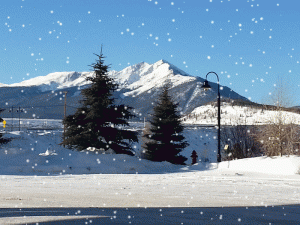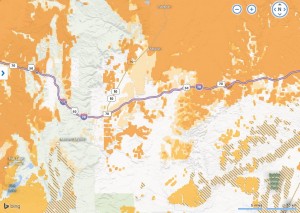 I just came back from a road trip from our home in CT to Las Vegas. My son moved there and he needed a car so I drove with him. It was a great trip. My wife and I did an unforgettable road trip in 1984 from NY City to LA and back. The route that my son and I took to get to Vegas had a lot in common with the route that my wife and I took coming back east in 1984. The variation in the landscape from Ohio to Nevada is amazing. The most breathtaking part for me is always the transition from Colorado to Utah to Arizona and Nevada. Whereas the time scale in which the nature changes is many orders of magnitudes slower, the technology around it is changing rapidly. But then, technology is not changing as rapidly in certain places, even in this country, one of the most advanced ones in the world!
I just came back from a road trip from our home in CT to Las Vegas. My son moved there and he needed a car so I drove with him. It was a great trip. My wife and I did an unforgettable road trip in 1984 from NY City to LA and back. The route that my son and I took to get to Vegas had a lot in common with the route that my wife and I took coming back east in 1984. The variation in the landscape from Ohio to Nevada is amazing. The most breathtaking part for me is always the transition from Colorado to Utah to Arizona and Nevada. Whereas the time scale in which the nature changes is many orders of magnitudes slower, the technology around it is changing rapidly. But then, technology is not changing as rapidly in certain places, even in this country, one of the most advanced ones in the world!
We left right after the big snow storm last thursday and the roads were pretty bad in CT as well as most of NY. Weather prediction technologies have become fairly sophisticated and we knew with fair certainty when the snow will end, so we could plan accordingly. The very first talk I gave in this country was a required talk for all PhD students in Chemistry. The subject of the talk is required to be not directly related to Chemistry. Because of my interests in computational methods, I chose the topic of weather modeling. The models that I spoke about at that time were being developed in National Oceanic and Atmospheric Administration. In simple terms, it involves solving complex differential equations and evaluating predictive values using advanced numerical methods. This requires prior values of many variables, dividing up the atmosphere into cubes and solving the equations within the cubes. Of course, you have to make sure that the values at the edges of the cubes are within the margin or error. Humongous number of calculations were done using the supercomputers (probably slower than the most powerful PCs of today) available then. Of course, the weather accuracy depended on how good the prior values are (these were reported by various weather stations) and how small a cube is. The smaller the cubes are, the better the accuracy can be, but it requires exponentially more computing power. Anyways, before I get carried away too much – even the simplest model in 1978/1979 required so much computer time that the predictions arrived 5 days after the weather had passed. Look where the technology has taken us now!
The advances in technology and its ubiquity is something we all take for granted. We were listening to songs and sports talk that my son had downloaded to his iPhone the previous night or many times streaming them because the quality of connection was pretty good. I was able to work on my Mac and the tablet with the MiFi connected. The Mac is notorious for energy consumption, so I ran out of battery several times, but the tablet was fine because it could be powered by the connector in the car. We both were in touch with the world through social media, breaking news and talking over the phone. In other words, just the fact that we were driving made little difference in comparison to what we would have done staying at home. And, we were snapping pictures left and right using the phone. Though I had taken a digital camera with me, I hardly had to pull it out.
 All of this changed when we went past Grand Junction, CO and entered Utah. I am an AT&T customer, so I have attached the coverage map in the area that I am referring to. It is the stretch of I-70 where you see no orange color. The connection was highly unreliable or non-existent for miles at a time. Of course, there are several little towns that we passed by, but no connections. I experience the same while traveling in certain parts of Vermont. This imbalance is driven by nothing but money. Cell towers, which have become the backbone for providing both telephone and data coverage for the smart phones, are not cheap. The phone companies therefore provide the service only where they are profitable. On the one hand, this makes sense, but this imbalance has severe consequences to those who live in these sparsely populated areas or poor areas.
All of this changed when we went past Grand Junction, CO and entered Utah. I am an AT&T customer, so I have attached the coverage map in the area that I am referring to. It is the stretch of I-70 where you see no orange color. The connection was highly unreliable or non-existent for miles at a time. Of course, there are several little towns that we passed by, but no connections. I experience the same while traveling in certain parts of Vermont. This imbalance is driven by nothing but money. Cell towers, which have become the backbone for providing both telephone and data coverage for the smart phones, are not cheap. The phone companies therefore provide the service only where they are profitable. On the one hand, this makes sense, but this imbalance has severe consequences to those who live in these sparsely populated areas or poor areas.
In the middle of driving in this area, it suddenly occurred to me that if something were to happen to the car while I was buzzing away at 80 mph (well, it was a 75 mph zone), what will I do? There is no cell coverage for miles and we saw very few cars and trucks on the road, so how does one call for help? I guess we would have flagged a car and hope that they stop to get us some help. We were warned of no gas stations for a stretch of 110 miles in Utah. What if we got stuck in the 55th mile? OK, I know I should relax. After all it is two adults that are driving and that I should infuse a sense of adventure into me. But my mind goes to “what if someone mugs me in the middle of nowhere?” (though I think that trying to mug someone in those vast stretches of nothingness would be a rather poor return on investment).
Oh, I forgot to tell you that my son and I are those who wait for the last drop of gas to be used up before we stop to fill gas and in one of the stretches. We both overlooked the lack of gas stations for several miles and somewhere along the way saw the “you have 15 miles to go” sign in the dashboard, with no indication of when we will be able to find the next gas station. Thankfully we found one before the last drop was about to run out!
On a serious note, these are the areas where I think having better communication is essential. Dangerous accidents can happen while driving at those legally permitted high speeds. During the summer and extreme heat, cars can break down. Besides, the many Indian reservations in the area are seriously disadvantaged by the lack of access to technology and providing access would be a great thing for their advancement. I do understand that this may not be of interest to the telephone companies who are very much profit driven. Perhaps, this is where government can use its resources to help solve the problem.
All through the trip, we had no issues at all with the GPS. It is quite conceivable that satellite based technology can be used as an easy way to help solve this issue. I have always been amazed by the whole GPS business model. We pay up front to purchase the GPS and do not pay a penny afterwards and do not even pause to think for a minute as to what the costs are for providing data to GPS every time we drive. For a detailed description of how the GPS works, how many satellites help us locate ourselves precisely and how much information they pass on, click here.
OK, comparing GPS transmission to data network is a stretch. But, the point I wanted to make is that providing data access to these remote places is possible through satellite based technology. Whereas it has its own issues (relating to weather conditions), it is available today. Perhaps those who drive through these remote places who want the comfort of communications can pay a fee for purchasing the service and this in some way can help subsidize providing internet service to those who live there.
Hopefully the next time I drive in those vast, breathtaking areas in the west, I will have uninterrupted communication with the rest of the world. Otherwise, I will feel like the way the astronauts must feel upon re-entry to the earth (Communication blackout), except, it lasts only a few minutes!